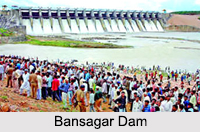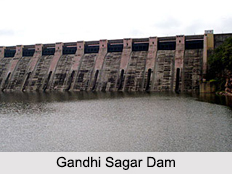 Dams in Madhya Pradesh have been constructed over several rivers with the aim of providing water for the irrigation of agricultural lands. These dams also serve as the major source of drinking water and generation of hydro-electric power. Some of these dams are tourist destinations of the state. Dams in Madhya Pradesh help in boosting the economy in agriculture of the state to a large extent. Described below are some of the prominent dams in Madhya Pradesh like Bansagar Dam, Bargi Dam, Barna Dam and Gandhi Sagar Dam.
Dams in Madhya Pradesh have been constructed over several rivers with the aim of providing water for the irrigation of agricultural lands. These dams also serve as the major source of drinking water and generation of hydro-electric power. Some of these dams are tourist destinations of the state. Dams in Madhya Pradesh help in boosting the economy in agriculture of the state to a large extent. Described below are some of the prominent dams in Madhya Pradesh like Bansagar Dam, Bargi Dam, Barna Dam and Gandhi Sagar Dam.
Bansagar Dam
Bansagar Dam or Ban Sagar Dam is situated on the Ganga River Basin in a village called Deolond in Shahdol district of Madhya Pradesh. It is a multipurpose river valley project, built on the Son River. The governments of Madhya Pradesh, Bihar and Uttar Pradesh decided upon an agreement in the year 1973 for the construction of the dam. The construction of this dam was initiated in the year 1978. The dam has a height of about 67 meters (220 ft) and a length of about 1,020 meters (3,350 ft). The main purpose of constructing the dam was to improve both hydroelectric power generation and irrigation. 
Bargi Dam
Bargi Dam is situated in Bargi in Jabalpur district, Madhya Pradesh. This is the first dam of its kind which was constructed over the Narmada River. The construction work of the Bargi Dam was initiated in the year 1974 and was completed in the year 1990, when the dam reached its full capacity. The dam has a height of about 69 meters and a length of about 5357 meters. This dam is one of the chief sources of water and its water is also utilized for the generation of hydro electric power.
Barna Dam
Barna Dam, situated in Badi tahsil in Raisen district of Madhya Pradesh has been constructed over the Barna River. The dam was opened in the year 1978. It has a height of nearly 47.7 meters (156 ft) and a length of about 432 meters (1,417 ft). This dam acts as a prime source of irrigation.
Gandhi Sagar Dam
Gandhi Sagar Dam, situated in the Mandsaur district of Madhya Pradesh has been constructed on Chambal River. The construction of this dam was started in 1954 and was completed in 1970. Water Resources Department of Madhya Pradesh is in charge of maintaining the Gandhi Sagar Dam. This dam has a height of around 62.17 meters and a length of about 514 meters.
Rajghat Dam
Rajghat Dam is situated in Ashok Nagar district in Madhya Pradesh and at a distance of about 22 kilometers from Lalitpur in Uttar Pradesh. The dam stands on the Betwa River. It is an inter-state project constructed in collaboration of the state governments of Uttar Pradesh and Madhya Pradesh.
Other Dams in Madhya Pradesh
Some of the other Dams in Madhya Pradesh are Indirasagar Dam, Bheemgarh Dam, Kerwa Dam and Bhadbhada Dam



















